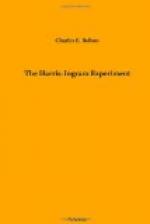It was two o’clock that night before George could close his eyes, but promptly at 6:30 o’clock next morning he was ready for his bath and shave, and later he and the colonel ate the usual European breakfast of eggs, rolls, and coffee. The eight o’clock train was taken for the great works of Siemens Brothers & Co., Limited, which are located at Woolwich, down the Thames.
This firm, the pioneers of ship lighting by electricity, has already fitted out hundreds of vessels with electric lights. They also manufacture submarine and land telegraphs in vast quantities, having aided largely in enclosing the globe in a network of cables. All the Siemens brothers have shown much ability. Charles William was born at Lenthe, Hanover, in 1823, and has received high scientific honors. The world recognizes the valuable services that Dr. Siemens has rendered to the iron and steel trade by his important investigations and inventions.
Dr. Siemens, like Mr. Bessemer, labored to make iron and steel direct from the ores. By the invention of his regenerative gas furnace, which makes the high grade and uniform steel so desirable in the construction of ships, boilers, and all kinds of machines, Dr. Siemens has rendered signal service. This visit at Siemens Brothers & Co.’s works was of great interest, and many valuable ideas were gained.
Several days were next spent in Birmingham, and at the centers of steel making in northwest England. Birmingham is called the “Toy Shop of the World” for there almost everything is manufactured from a cambric needle to a cannon.
Colonel Harris and George Ingram studied the workings of the English “Saturday half-holiday,” which employees earn by working an extra half-hour on the five previous days. A visit was made to the Tangye Bros. Engine Works at Soho, near Birmingham, which absorbed the engine works of Boulton and Watt. It was Boulton who said to Lord Palmerston visiting Soho, “Sir, we have here for sale what subjects of his Majesty most seek, viz., Power.”
The Tangyes employ thousands of men, manufacturing engines and other products. Steam engines of all sizes, in enormous quantities are stored, ready at a moment’s notice to be shipped broadcast. It was the invention of the powerful Tangye jack-screw that finally enabled the famous engineer Brunel to launch his “Great Eastern” steamship which he had built on the Thames, and which had settled on her keel.
Today the Tangye Brothers are fond of saying, “We launched the ’Great Eastern,’ and the ‘Great Eastern’ launched us.” One of the Tangye Brothers took the two Americans through James Watt’s old home, and into his famous garret, where Watt invented the parallel motion and other parts of the steam engine. So important were Watt’s engine inventions that he alone should have the honor of inventing the modern engine which has so elevated the race.
George was greatly interested in what the Tangye Brothers were doing for their employees. Instructive lectures by capable men were given weekly to their workmen, while they ate their dinners. Medical aid was furnished free, and in many ways practical assistance was rendered their working force.




